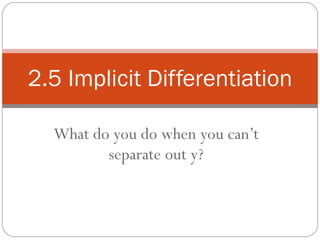Calc 2.5a
•Transferir como PPT, PDF•
0 gostou•305 visualizações
Implicit Differentiation
Denunciar
Compartilhar
Denunciar
Compartilhar

Recomendados
Recomendados
Mais conteúdo relacionado
Mais procurados
Mais procurados (20)
Limit, Continuity and Differentiability for JEE Main 2014

Limit, Continuity and Differentiability for JEE Main 2014
Chapter 1: First-Order Ordinary Differential Equations/Slides 

Chapter 1: First-Order Ordinary Differential Equations/Slides
MetiTarski: An Automatic Prover for Real-Valued Special Functions

MetiTarski: An Automatic Prover for Real-Valued Special Functions
Destaque
Destaque (10)
3.2 implicit equations and implicit differentiation

3.2 implicit equations and implicit differentiation
Semelhante a Calc 2.5a
Semelhante a Calc 2.5a (20)
First Order Ordinary Differential Equations FAHAD SHAHID.pptx

First Order Ordinary Differential Equations FAHAD SHAHID.pptx
Mais de hartcher
Mais de hartcher (20)
Último
Mehran University Newsletter is a Quarterly Publication from Public Relations OfficeMehran University Newsletter Vol-X, Issue-I, 2024

Mehran University Newsletter Vol-X, Issue-I, 2024Mehran University of Engineering & Technology, Jamshoro
Último (20)
Role Of Transgenic Animal In Target Validation-1.pptx

Role Of Transgenic Animal In Target Validation-1.pptx
Asian American Pacific Islander Month DDSD 2024.pptx

Asian American Pacific Islander Month DDSD 2024.pptx
Food Chain and Food Web (Ecosystem) EVS, B. Pharmacy 1st Year, Sem-II

Food Chain and Food Web (Ecosystem) EVS, B. Pharmacy 1st Year, Sem-II
ICT Role in 21st Century Education & its Challenges.pptx

ICT Role in 21st Century Education & its Challenges.pptx
Micro-Scholarship, What it is, How can it help me.pdf

Micro-Scholarship, What it is, How can it help me.pdf
ICT role in 21st century education and it's challenges.

ICT role in 21st century education and it's challenges.
Unit-IV; Professional Sales Representative (PSR).pptx

Unit-IV; Professional Sales Representative (PSR).pptx
Measures of Central Tendency: Mean, Median and Mode

Measures of Central Tendency: Mean, Median and Mode
This PowerPoint helps students to consider the concept of infinity.

This PowerPoint helps students to consider the concept of infinity.
Energy Resources. ( B. Pharmacy, 1st Year, Sem-II) Natural Resources

Energy Resources. ( B. Pharmacy, 1st Year, Sem-II) Natural Resources
Calc 2.5a
- 1. What do you do when you can’t separate out y? 2.5 Implicit Differentiation
- 2. Up to now we have seen most equations in explicit form – that is, y in terms of x, like y = 2x 6 -5 (solved for y alone) Now we will work with equations written implicitly, like xy=8. This is the implicit form; it can be rewritten explicitly as y = 8/x Sometimes we can isolate y. Sometimes we can’t! For example, x 2 + 2y 3 + 4y = 2. So we will learn how to implicitly differentiate to handle any situation. When we find dy/dx, we are differentiating with respect to x. Anytime we see a term with x alone, we differentiate as usual. Whenever we differentiate a term involving y, we must apply the Chain Rule, because you are assuming there is some function where y could be written implicitly.
- 3. When we find dy/dx, we are differentiating with respect to x. Anytime we see a term with x alone, we differentiate as usual. Whenever we differentiate a term involving y, we must apply the Chain Rule, because you are assuming there is some function where y could be written implicitly. Ex 1 p. 141 Differentiating with Respect to x Variables agree: Use simple power rule Variables disagree: Use Chain Rule Product Rule,Chain
- 6. Input y = t, y=t for Play around with window values until you get graph shown. Would you like to see what this graph looks like?
- 7. Ex 3 p. 143 Representing graphs by differentiable functions. If possible, represent y as a differentiable function of x. Just a single point, so not differentiable Differentiable except at (1, 0) and (-1, 0) Differentiable except at (1, 0)
- 8. Ex 4 p.143 Finding the Slope of a Graph Implicitly Determine the slope of the tangent line to the graph of Differentiate with respect to x Get dy/dx terms alone, then solve for dy/dx Substitute x and y from point of tangency and simplify. If you want to do it the hard way, solve original equation for y and differentiate that.
- 9. Ex 5 p. 144 Finding the Slope of a Graph Implicitly Determine the slope of Plug in point (3, 1) This graph is called a lemniscate
- 10. Ex 6, p144 Determining a Differentiable Function Range Find dy/dx implicitly for equation sin y = x (note: inverse function y = sin -1 x). Find the largest interval for y values on which x is differentiable. Or alternatively, Graph becomes vertical at endpoints of interval!
- 11. 2.5a p. 146 #1-16 all, 21,23,25